How to Plant a Lemon Tree: Complete Guide with Images and Steps to Follow
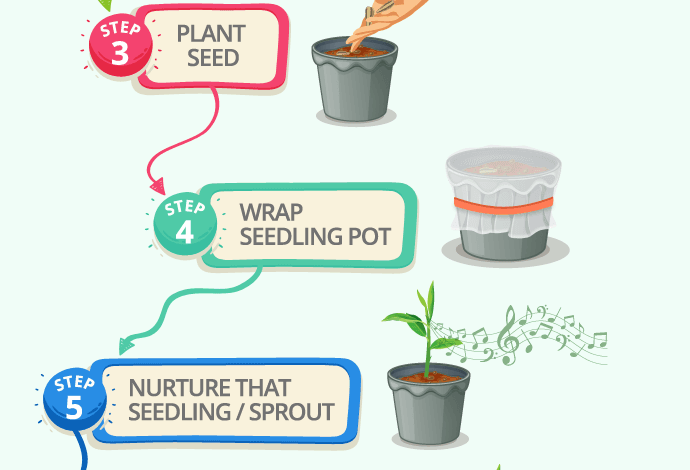
Among citrus and fruit trees, the lemon tree is undoubtedly one of the most popular around the world.
Due to its ease of cultivation and the large number of benefits that its fruits provide, it is one of the trees that is most widely planted in orchards and gardens.
If you want to plant a tree at home and you haven’t decided yet, we invite you to try a lemon tree.
It’s simple and fun.Here we explain the best way for you to do it successfully.
Important points to plant a lemon tree:
- When? At the end of March.
- Where? Place of maximum sun exposure. It requires between 8-12 hours of light. Mediterranean climate. It does not tolerate the cold well.
- Harvest time? Between 3 and 6 years to bear the first fruits.
- How do we prepare the land? It prefers permeable soils, well drained and little limestone. They do not tolerate salinity. Good contribution ofhomemade organic matter such as compost.
- How do we water? Ideal, drip irrigation. They do not tolerate waterlogging well.
- How do we sow? Here step by step.
- How do we harvest? There are usually 3 harvests a year, although some varieties can take between 7-9 months to mature.
- Plagues and diseases? Black aphid, spider mite, citrus leafminers, alternaria.
When should a lemon tree be planted? The dates
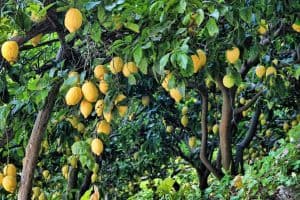 As it is a fruit tree, it is recommended to plant itat the end of March.
As it is a fruit tree, it is recommended to plant itat the end of March.
May and early June are also a good time, since it corresponds to the time when all tree species are generally planted.
The lemon tree blooms almost all year round, with the exception of the coldest months.
Likewise, it can be harvested throughout the year, depending on the variety that we plant. Generally, three harvests are made a year.
Where do we want to plant a lemon tree? light and temperature
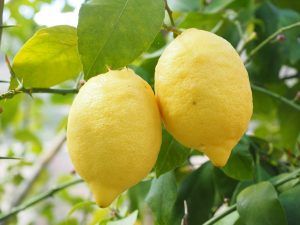 It is a citrus that grows very well in Mediterranean climates, where winters are not very cold and high temperatures are obtained in summer.
It is a citrus that grows very well in Mediterranean climates, where winters are not very cold and high temperatures are obtained in summer.
So,it is not very cold tolerantIn fact, it is the citrus fruit with the greatest sensitivity to cold.
The lighting conditions must be total, so it is best to place it in an open field, away from any obstacle that could cause it to shade.
They need between 8 and 12 hours of sunlight in the day.
Its optimum growth temperature varies between 20 and 25 °C during the day and between 15 and 18 °C at night.
- Temperatures below 12 °C cause a state of lethargy in the lemon tree and it stops growing.
- Low temperatures and water stress result in the arrest of the development of the root system.
How and how often are we going to water it?
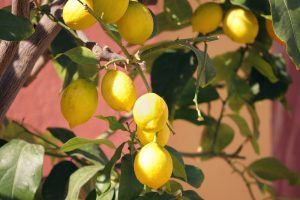 The lemon tree is quite prone to root suffocation, so it is important to have good drainage in the soil so as not to cause waterlogging.
The lemon tree is quite prone to root suffocation, so it is important to have good drainage in the soil so as not to cause waterlogging.
On the contrary, they are relatively resistant to drought, since their roots allow them to adapt very well to a wide variety of relative humidity conditions.
They can be grown in desert, sub tropical and tropical regions.
Autumn rains in temperate climates improve fruit size and quality, while hot, dry seasons coincide with the fruit growth period.
If you plant it indoors, it is recommended to maintain the relative humidity in the room, by means of humidifiers or frequent spraying of the leaves, so that the natural humidity that the tree loses by not being outside is imitated.
The soil should be watered when the top layers, the first 5 cm, feel moderately dry to the touch.Great care must be taken not to generate puddles.
How do we prepare the land for growing a lemon tree?
To know more: How to fertilize a lemon tree.
Prefers permeable soils, well drained and little limestone.
The soil must be deep to allow good root development and proper anchoring. In addition, a floor with a balanced proportion of coarse and fine elements is recommended to guarantee good aeration and facilitate the passage of water.
They do not tolerate salinity
The lemon tree requires a soil with a balance ofpH between 6.1 and 7.8
If you are going to use tap water for irrigation, it is recommended to lower its pH. For this, you can add 1 tablespoon of white vinegar for every 4 liters of water.
Lemon trees can reach up to 6 meters in height, and some varieties can even be grown in pots placed indoors.
Outdoors, you should keep in mind that you shouldplant the tree leaving at least 5 metersaway from any other tree.
How to plant a lemon tree step by step (20 steps)
- Clear the ground. Extract weeds and remains of previous crops and all kinds of residues to ensure that your lemon tree receives the right amount of nutrients.
- All plants must be pulled out by the roots to prevent them from growing back.
- Prepare the ground.Moisten the ground before planting; This reduces the risk of the shoots being moved by the force of the water.
- Fertilize the soil.Spread a 1-inch layer of compost on top of the soil. Make sure to loosen the soil about 1 meter deep, to ensure the anchorage of the roots. If you decide to sow the seeds in a pot, follow these steps:
- First, make sure your lemon tree is a variety that doesn’t grow taller than 10 feet.
- Get a 60 liter pot with good drainage.Fill it in with a good peat -based soil mix. At the bottom you can deposit pebbles and gravel to facilitate drainage and good root anchoring.
- Put the seeds in the soil.Place each seed at a depth of 2.5 centimeters and cover it with soil. Water immediately to keep the soil moist.
- If you plant indoors, make sure to place the pot in a well-lit spot. At first it will require between 10 and 12 hours of light a day.
- The first shoots will begin to emerge at three weeks. You will have to wait a few months for it to reach a considerable height and be ready to transplant, in case you wish to do so.
- Protect the tree and give it good maintenance.Water them as soon as you notice that the top layers of the soil are about to dry out. Put up a chain link mesh to protect the plants while they are growing.
- You can feed it with an organic fertilizer, such as earthworm humus or iron sulfate. If you prefer, you can use a fertilizer with high levels of nitrogen and moderate levels of phosphorous and potassium.
- Make sure to maintain relative humidity in the environment, if you have the tree indoors.
- Regularly prune the plants.Throughout the life cycle of the lemon tree, we will remove the leaves in poor condition. This is recommended during the spring, after the harvest and as long as there is no danger due to low temperatures.
- Dead branches, however, should be removed immediately at any time of the year.
- To prune branches, use garden shears to make a clean cut near the base of the branch.
- Keep in mind that pruning too many leaves will reduce production.
- Pollinate the flowers.
- If you have grown lemon trees to harvest their fruits, it is necessary to pollinate the flowers. Bees and other insects are the most common pollinators for lemons.The easiest way to promote pollination is by having multiple trees.
- When you have two or three trees growing together, the bees will begin to carry pollen from one tree to another. However, if you have your tree indoors, you prevent insects from carrying out the pollination tasks. If this is the case, you can do it yourself. Once the tree blooms, gently rub the antlers on the inside of each flower with a cotton swab.
- The antlers are the yellow tips that protrude from the center of the flower. When you rub them, you will notice that a yellow powder accumulates on the head of the swab. This is the pollen. Now, gently rub it on the sticky lobes of the pistil, which is the central stem that protrudes from the other stems in the middle of the flower. We prefer to do this process soon, as this prevents the pollen from dying due to heat or dryness.
- Consider that the lemon tree takes between three and six years before it begins to bear fruit. The fact that you have a strong and healthy tree does not guarantee that it will bear fruit.
- To make sure it does, you may want to consider grafting. In other words, you must place the cutting of a tree that does bear fruit in the trunk of your tree so that they merge and become a single plant.
- There are different ways to make grafts. We recommend that you consult an expert to guide you in the most effective way to do it. You will also need to make sure that both species you plan to graft are compatible.
To know more, you can see: Cuttings of lemon tree.
How to harvest lemons
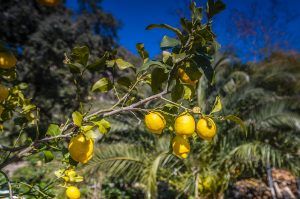 To guarantee a good harvest, fruit thinning is important.
To guarantee a good harvest, fruit thinning is important.
Once bunches of lemons appear on the tree, remove two-thirds of them so the remaining third can mature to its normal size.
Typically, lemons take 7-9 months to ripen.
Lemons harvested in the dark green state have a longer postharvest life, while those harvested yellow must be consumed almost immediately.
Harvesting is manual and must be done with pliers, avoiding pulling. You can also try turning them, as ripe lemons usually come off very easily.
Preferably, collect in the afternoon, when the dew has evaporated.
Pests and diseases of the lemon tree
To learn more about the pests and diseases that affect the lemon tree, take a look at this article: Pests and Diseases of the lemon tree.
Some of the most common pests and diseases that affect the lemon tree are:
Black aphid (Myzus cerasi)
It causes the rolling of the leaves and tender shoots.
For its control, it is recommended to apply potassium soap and neem oil.
Red Spider (Tetranychus urticae)
 It is a very resistant plague and difficult to fight, because they mutate easily from one generation to another.
It is a very resistant plague and difficult to fight, because they mutate easily from one generation to another.
For its control, it is recommended to keep the weed crops clean.
It is also recommended to avoid substrates with excess nitrogen.
In fairly dry climates it is recommended to water the tree at night to maintain moisture.
To combat an infestation, an extract of garlic and chili can be applied.
Citrus leafminers (Phyllocnistis citrella)
It produces galleries inside the leaves of green shoots, causing the entry of diseases.
For its control, it is preferable to place yellow traps or containers with sticky surfaces so that they adhere.
In addition, ecological alternatives can be used, such as applying 1% potassium soap sprayed with rainwater or distilled water to the underside of the leaves.
alternate
The fungus is spread by wind or water, increasing in humid conditions.
Plants are more susceptible to being affected when they are subjected to stress conditions or nutritional deficiencies.
To combat it, good ventilation of the tree is recommended.
Among the active ingredients of possible use we have horsetail and potassium soap.
ribbed cochineal
The ribbed mealybug infests twigs and branches.
It is hermaphrodite and oval in shape, reddish brown with black hairs, 5 mm long.
When mature, the insect remains immobile, adheres to the plant by means of waxy secretions, and produces a white egg sac in grooves, by extrusion, in the body enclosing hundreds of red eggs.
The egg sac will grow to be two to three times as long as the body. Newly hatched nymphs are the primary dispersal stage, with dispersal known to occur by wind and drift.
Where can I buy a lemon tree?
We always recommend going to a nursery in the town where you live. This way you can be advised by professionals.
In case you don’t have one, you can also buy a lemon tree on Amazon:
Lemon tree 4 seasons – Pot 22cm. Overall height approx. 1’2m. – Live plant – (Shipping only to the Peninsula)
- Year-round lemons, Eureka variety.
- Fine skin and lots of juice. Great for table.
- Abundant production. It does not support frost.
- Scientific name: Citrus Lemon
€25.89 View on Amazon Prices with VAT without transport
Last updated on 2022-07-31 / Affiliate Links / Affiliate API Images
 Dwarf Lemon Tree 4 Seasons FREE SHIPPING €59.94 View on Amazon Prices with VAT without transport
Dwarf Lemon Tree 4 Seasons FREE SHIPPING €59.94 View on Amazon Prices with VAT without transport
Last updated on 2022-07-31 / Affiliate Links / Affiliate API Images
How long does a lemon tree live?
The average lifespan of a lemon tree is 70 years.
How long does it take to grow a lemon tree?
The lemon tree grows about 30 centimeters per year until it reaches a height of approximately 7 meters.
Its period of greatest growth is located in the first years of life, taking into account the environmental conditions to reach a good size.
How long does it take to produce fruit?
If planted from seed, a lemon tree can take up to 6 years to produce its first crop.
In case of using a small tree already worked in nurseries, the time will be reduced to approximately 3 years.
Can it be grown in a pot?
The lemon tree can be grown in a pot without major inconveniences, only taking into account that its growth and production will not be as abundant.
In addition, in that case it will require more attention in care such as irrigation and fertilization, since it will not have the natural support it gets outdoors.
How many times does a lemon tree produce fruit?
During the period of a year, a lemon tree can throw up to three harvests.
There are even species that if kept in tropical climates (without seasons) will generate up to 4 annual harvests.
Should a lemon tree be pollinated to obtain fruit?
The lemon tree needs the pollination process to generate fruit, which is produced thanks to the presence of bees.
It can also be pollinated manually, which in fact is essential in indoor cultivation.
This is done by taking the pollen from the male flowers to the female ones, with the help of a brush, and sticking them to the stigma when it is sticky.
To be successful in this process you have to stop to observe the parts of the flower in detail and practice.
How cold can a lemon tree tolerate?
They are not tolerant of extreme cold. In fact, they are not recommended in any area with frost because they can die if they are subjected to less than 0° C.
Lemon trees are warm climate plants, so they should be kept above 15° C in general.
How many lemon trees can be planted per hectare?
Depending on the characteristics of each lemon tree, an average of between 270 and 320 lemon trees per hectare is established.
This cultivation capacity gives enough space to produce more than 18 thousand kilos of fruit per hectare.
What kind of fertilizer does a lemon tree need?
Citrus fruits, such as lemon trees, are especially demanding in terms of fertilizer, so the main macronutrients must be provided.
The recommended titration for this case is NPK (16-8-8).
How much heat and/or drought can a lemon tree tolerate?
The lemon tree is from a warm climate but that does not imply that it should be subjected to excessive heat. Ideally, it should not be above 30 ° C.
And, as with citrus, it does not tolerate periods of drought.
To learn more, read: Lemon tree varieties.
More information on how to plant trees:



![Photo of Watermelon Pests and Diseases: [Detection, Causes and Solutions]](https://www.complete-gardening.com/wp-content/uploads/2022/08/watermelon-pests-and-diseases-detection-causes-and-solutions-390x220.jpg)
![Photo of Prune a Laurel: [Importance, Time, Tools, Considerations and Steps]](https://www.complete-gardening.com/wp-content/uploads/2022/08/prune-a-laurel-importance-time-tools-considerations-and-steps-390x220.jpg)